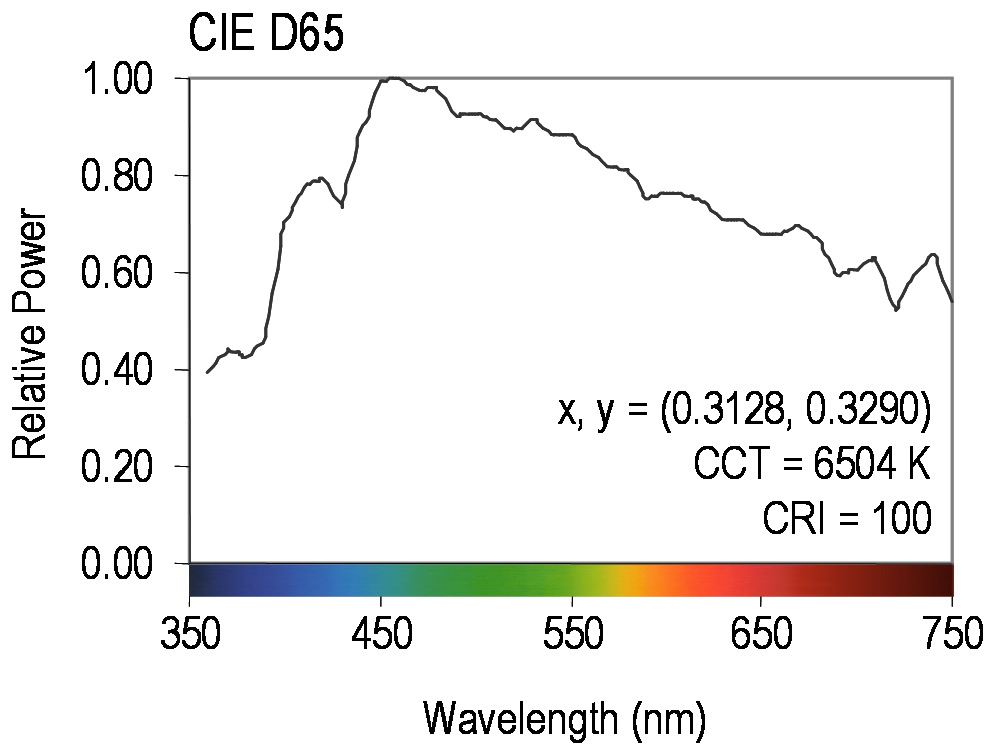|
Whiteness (colorimetry)
In colorimetry, whiteness is the degree to which a surface is white. An example of its use might be to quantitatively compare two pieces of paper which appear white viewed individually, but not when juxtaposed. The International Commission on Illumination describes it in the following terms: Calculation W_2=Y_2+800(x_-x_2)+1700(y_-y_2) W_=Y_+800(x_-x_)+1700(y_-y_) T_=1000(x_-x_2)-650(y_-y_2) T_=900(x_-x_)-650(y_-y_) where * Y is the Y tristimulus value (relative luminance), * (x,y) is the chromaticity coordinate in the CIE 1931 color space * (x_n,y_n) is the chromaticity coordinate of the perfect diffuser (reference white) The numbers in the subscript indicate the observer: two for the CIE 1931 standard observer and ten for the CIE 1964 standard observer. Notes * W increases with whiteness, reaching 100 for the perfect diffuser. * The tint is green for positive T and red for negative T. * Equal differences in W may not appear equally different. See also * Color temper ... [...More Info...] [...Related Items...] OR: [Wikipedia] [Google] [Baidu] |
Colorimetry
Colorimetry is "the science and technology used to quantify and describe physically the human color perception". It is similar to spectrophotometry, but is distinguished by its interest in reducing spectra to the physical correlates of color perception, most often the CIE 1931 XYZ color space tristimulus values and related quantities. History The Duboscq colorimeter was invented by Jules Duboscq in 1870. Instruments Colorimetric equipment is similar to that used in spectrophotometry. Some related equipment is also mentioned for completeness. * A tristimulus colorimeter measures the tristimulus values of a color. * A spectroradiometer measures the absolute spectral radiance (intensity) or irradiance of a light source. * A spectrophotometer measures the spectral reflectance, transmittance, or relative irradiance of a color sample. * A ''spectrocolorimeter'' is a spectrophotometer that can ''calculate'' tristimulus values. * A densitometer measures the degree of light ... [...More Info...] [...Related Items...] OR: [Wikipedia] [Google] [Baidu] |
International Commission On Illumination
The International Commission on Illumination (usually abbreviated CIE for its French name, Commission internationale de l'éclairage) is the international authority on light, illumination, colour, and colour spaces. It was established in 1913 as a successor to the Commission Internationale de Photométrie, which was founded in 1900, and is today based in Vienna, Austria. Organization The CIE has six active divisions, each of which establishes technical committees to carry out its program: * Division 1: Vision and Colour * Division 2: Physical Measurement of Light and Radiation * Division 3: Interior Environment and Lighting Design * Division 4: Transportation and Exterior Applications * Division 6: Photobiology and Photochemistry * Division 8: Image Technology Two divisions are no longer active: * Division 5: Exterior Lighting and Other Applications * Division 7: General Aspects of Lighting The President of the CIE from 2019 is Dr Peter Blattner from Switzerland. CIE publi ... [...More Info...] [...Related Items...] OR: [Wikipedia] [Google] [Baidu] |
Tint
In color theory, a tint is a mixture of a color with white, which increases lightness, while a shade is a mixture with black, which increases darkness. Both processes affect the resulting color mixture's relative saturation. A tone is produced either by mixing a color with gray, or by both tinting and shading. Mixing a color with any neutral color (including black, gray, and white) reduces the chroma, or colorfulness, while the hue (the relative mixture of red, green, blue, etc. depending on the colorspace) remains unchanged. In the graphic arts, especially printmaking and drawing, "tone" has a different meaning, referring to areas of continuous color, produced by various means, as opposed to the linear marks made by an engraved or drawn line. In common language, the term ''shade'' can be generalized to encompass any varieties of a particular color, whether technically they are shades, tints, tones, or slightly different hues. Meanwhile, the term ''tint'' can be gener ... [...More Info...] [...Related Items...] OR: [Wikipedia] [Google] [Baidu] |
Standard Illuminant
A standard illuminant is a theoretical source of visible light with a spectral power distribution that is published. Standard illuminants provide a basis for comparing images or colors recorded under different lighting. CIE illuminants The International Commission on Illumination (usually abbreviated CIE for its French name) is the body responsible for publishing all of the well-known standard illuminants. Each of these is known by a letter or by a letter-number combination. Illuminants A, B, and C were introduced in 1931, with the intention of respectively representing average incandescent light, direct sunlight, and average daylight. Illuminants D represent variations of daylight, illuminant E is the equal-energy illuminant, while illuminants F represent fluorescent lamps of various composition. There are instructions on how to experimentally produce light sources ("standard sources") corresponding to the older illuminants. For the relatively newer ones (such as series D), exp ... [...More Info...] [...Related Items...] OR: [Wikipedia] [Google] [Baidu] |
CIE Standard Illuminant D65
CIE standard illuminant D65 (sometimes written D65) is a commonly used standard illuminant defined by the International Commission on Illumination (CIE). It is part of the D series of illuminants that try to portray standard illumination conditions at open-air in different parts of the world. D65 corresponds roughly to the average midday light in Western Europe / Northern Europe (comprising both direct sunlight and the light diffused by a clear sky), hence it is also called a daylight illuminant. As any standard illuminant is represented as a table of averaged spectrophotometric data, any light source which statistically has the same relative spectral power distribution (SPD) can be considered a D65 light source. There are no actual D65 light sources, only simulators. The quality of a simulator can be assessed with the CIE metamerism index. The CIE positions D65 as the standard daylight illuminant: History The CIE introduced three standard illuminants in 1931: * A: Incandes ... [...More Info...] [...Related Items...] OR: [Wikipedia] [Google] [Baidu] |

